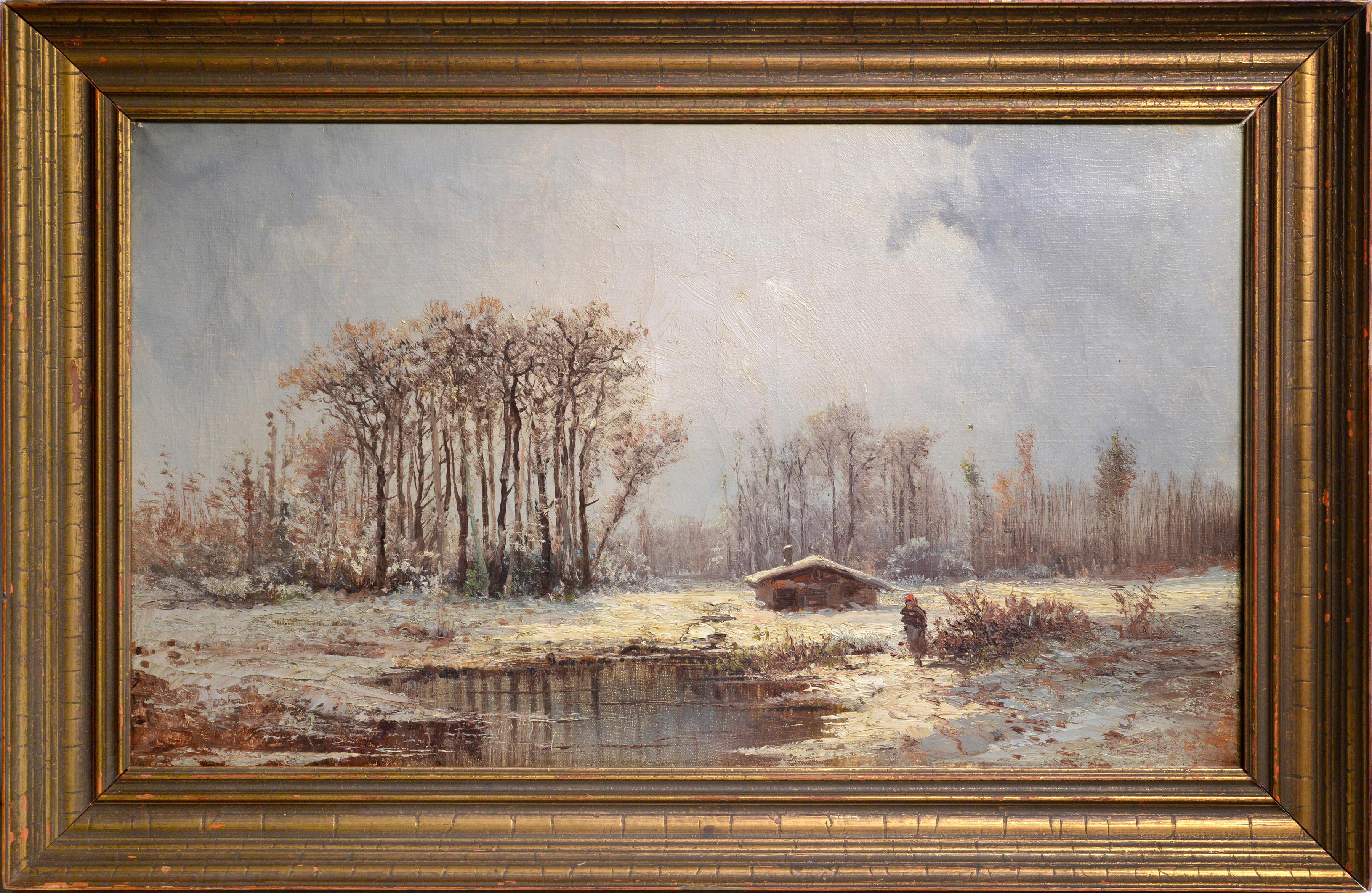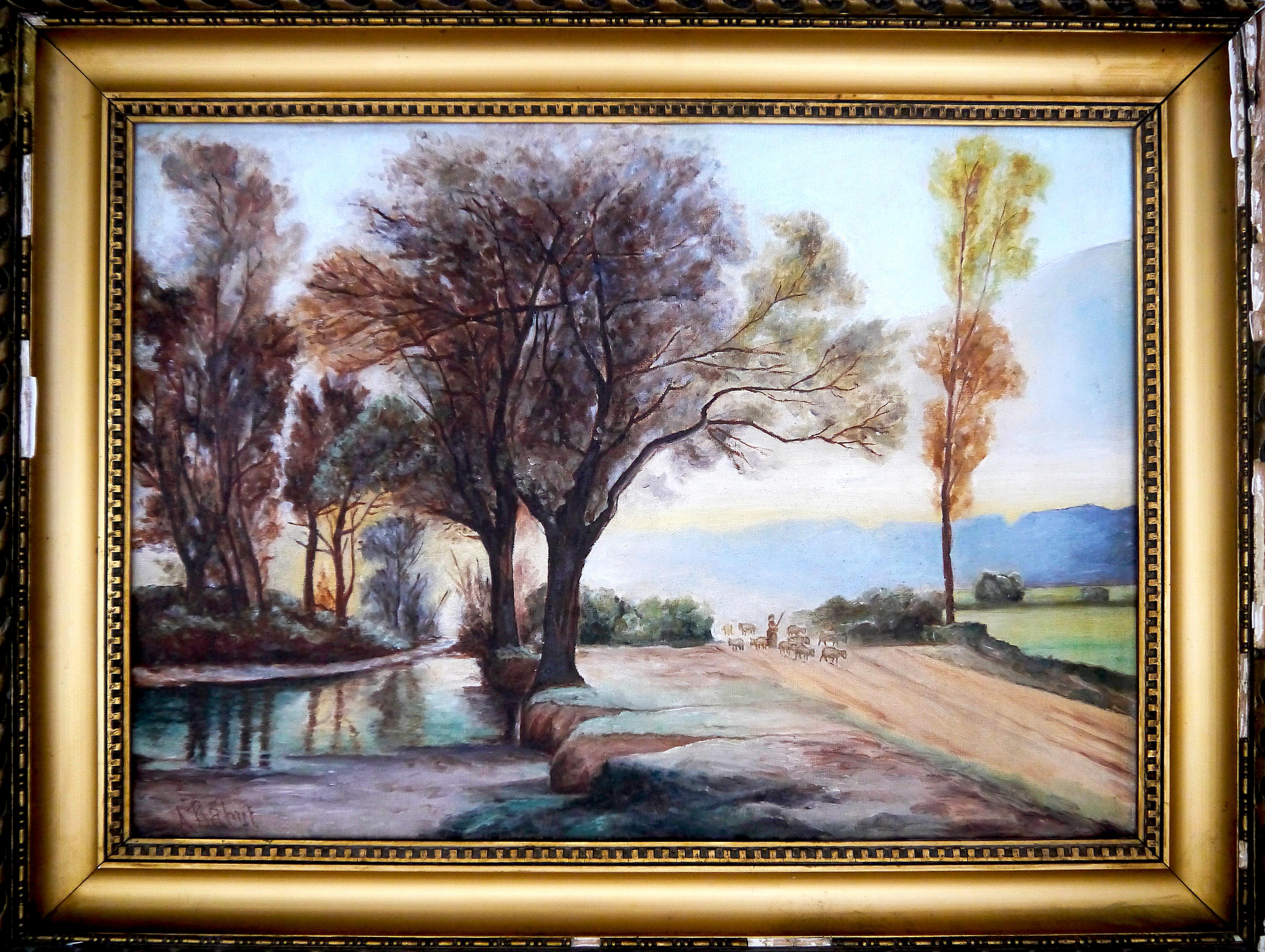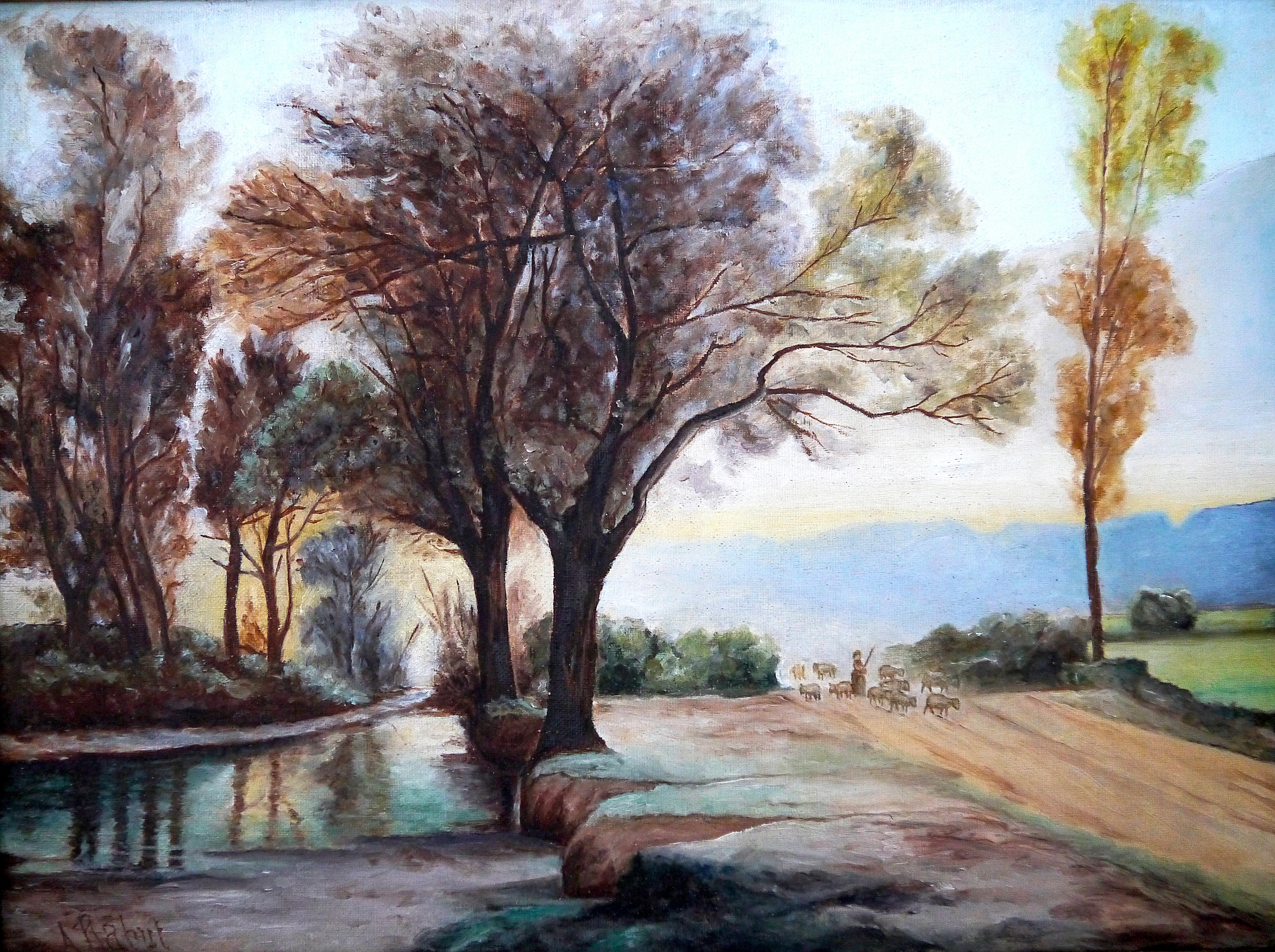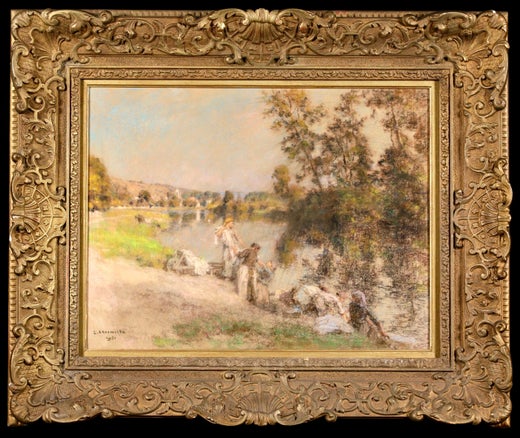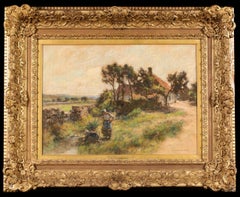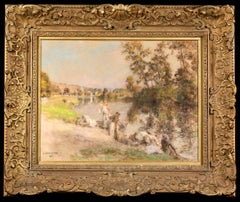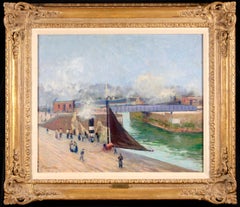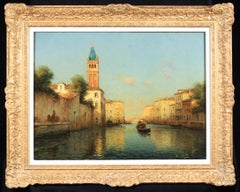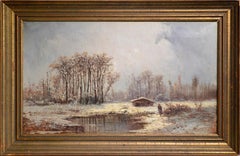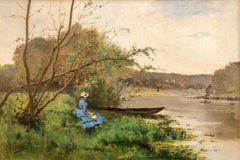Articles similaires à Lavandieres - Barbizon Figurative Landscape Pastel by Leon Lhermitte
Vous voulez plus d'images ou de vidéos ?
Demander au vendeur plus d'images ou de vidéos
1 sur 19
Léon Augustin LhermitteLavandieres - Barbizon Figurative Landscape Pastel by Leon Lhermitte1922
1922
À propos de cet article
Signed figures in riverscape oil on canvas by French Barbizon painter Leon Augustin Lhermitte. The piece depicts a rural landscape with washerwomen in traditional Breton clothing washing laundry from the bank of the River Marne, an eastern tributary of the Seine in the area east and southeast of Paris
Signature:
Signed and dated 1922 lower right
Dimensions:
Framed: 28.5"x33"
Unframed: 21.5"x26"
Provenance:
Societe Nationale des Beaux-Arts 1922 - No. 624
Galerie Georges Bernheim - Paris c. 1922 (likely acquired from the painter)
Howard Young Galleries - New York
John Levy Galleries - New York
Private collection - South America
Literature:
This work is described on p.280, no. 702 in the catalogue raisonne of the work of Leon L'Hermitte by Monique Le Pelley Fonteny who references our work in oil and its pastel version illustrated in the raisonne
Léon Augustin Lhermitte was the son of a school teacher. He painted from a very early age and settled in Paris in 1863, enrolling in the École Impériale de Dessin. His teacher was Lecocq de Boisboudran. In the early days of his career he earned a living doing illustrations for boxes of sweets and the catalogues of the cabinet-makers of the Faubourg St-Antoine, as well as publishing houses. In 1879 he went to Great Britain, to which he returned frequently. The same year he met the art dealer Paul Durant-Ruel who exhibited his works. He was one of the founders of the Société Nationale des Beaux-Arts, of which he became vice-president.
Lhermitte initially produced charcoal drawings which revealed his deep feeling for nature. His first attempt, Banks of the Marne near Alfort, caused a sensation. Following this he executed canvases, showing himself to be a fine landscape artist and a skilful draughtsman. He painted scenes from rural life almost exclusively and benefited from exceptional interest generated by the prizes awarded to the works of J. F. Millet. But although he was very much affected by the work of the painter of Angelus, he himself sought only the pictorial element and not a synthetic translation. Many other French masters of the period share his completely objective vision, for example Bastien Lepage, Roll, J. C. Cazin and Rafaelli. Like them, he put into practice very early on the technique of 'clear painting' made fashionable by the pursuit of Impressionism. But this group of artists borrowed from this method only those elements which appealed to public taste, and ignored chromatic elements. Lhermitte also paid the price for the easy success of those early days. His peasants, which found general favour with the public at the time, nowadays seem rather feeble alongside Camille Pissarro's renderings of the same subject.
However, in order to pass judgement on an artist such as Lhermitte, it is necessary to understand the era in which he worked, the era in which Realism was the only acceptable approach. It was in the atmosphere of the 'Théâtre Libre' of Antoine and the novels of Maupassant, Zola and their imitators that this type of art developed. In this context, Lhermitte is recognised as having painted the life of the peasants with great powers of objective observation and great insight into types and physiognomies. Nothing escaped his implacable eye and his bold and vigorous hand was guided by a lucid mind. The simplest elements of nature take on an air of true grandeur in his painting, despite their romantic and sentimental aspects. He is highly regarded both in France and in other countries by art lovers who look for nothing more than an attractive subject expertly painted. Among his most noteworthy works, outside those in museums, are: Les Halles, Washing the Sheep, Haymaking Time, and his large decorative panel for the Sorbonne, Claude Bernard. He illustrated A. Thieuret's Rural Life (La Vie Rustique).
He made his debut in 1864 in Paris at the Salon des Artistes Français. He subsequently took part in numerous collective exhibitions, notably the Exposition Universelle of 1900, in which he showed seven paintings, three pastels and four drawings. His early works gained him a third-place medal in 1874, a second-place medal in 1880, and the Grand Prix at the 1889 Exposition Universelle in Paris. He received a diploma of honour in Dresden in 1890 and was decorated with the Légion d'Honneur in 1884, promoted to Officier in 1884 and to Commandeur in 1911. He was elected to the Institut de France in 1905.
Museum and Gallery Holdings:
Albany (Institute of History and Art): Landscape
Amiens: Death and the Woodcutter
Boston (MFA): Soul of the Humble
Buffalo (Albright-Knox AG): Haymaking Time
Carcassonne: Harvest
Château-Thierry (Mus. Jean-de-La-Fontaine): View of Château-Thierry
Chicago (AI): Sheafing the Hay
Florence (Uffizi): Portrait of the Artist
Montreal (Learmont): Ruins of Château-Thierry
Moscow (State Tretyakov Gal.): Le Tréport; Small Courtyard in Normandy
New York (Metropolitan Mus. of Art): Grape Harvest (1884); Soul of the Humble (1905)
Paris (MAM): Jazz Quartet
Paris (Mus. d'Orsay): Harvesters' Wages
Paris (Mus. du Petit Palais): Les Halles
Rheims: Wine Press
St Louis (Washington University): Harvest (1883, oil on canvas); Haymaking Time (1891, oils on canvas, two paintings)
St-Quentin: Pardon of Ploumanac'h
Washington DC (Corcoran Gal. of Art): Family of Harvesters
- Créateur:Léon Augustin Lhermitte (1844-1925, Français)
- Année de création:1922
- Dimensions:Hauteur : 72,39 cm (28,5 po)Largeur : 83,82 cm (33 po)
- Support:
- Mouvement et style:
- Période:
- État:Very good original condition.
- Adresse de la galerie:Marlow, GB
- Numéro de référence:Vendeur : LFA02361stDibs : LU415316440382
Léon Augustin Lhermitte
L'hermitte se rendait souvent en Bretagne, car il était fasciné par la vie rurale qui y régnait. Son
Ses œuvres étaient exposées à Paris, mais il avait également un marchand qui les présentait aux États-Unis, au Canada et en Grande-Bretagne. En outre, son travail s'est également répandu par le biais de commandes dans des magazines illustrés. Vincent Van Gogh a écrit " Si chaque mois Le Monde Illustré publiait une de ses compositions...ce serait un grand plaisir pour moi de pouvoir le suivre... ". Il est certain que depuis des années je n'ai rien vu d'aussi beau que cette scène de L'hermitte...Je suis trop préoccupé par L'hermitte ce soir pour pouvoir parler d'autres choses." Originaire du nord-est de la France, Léon Augustin L'hermitte s'installe à Paris à temps pour participer au Salon des Refus en 1863. Pendant ses études à l'École des Beaux-Arts, il est reconnu après son exposition au Salon de Paris en 1874. Parmi les nombreuses récompenses qu'il a reçues, citons la Légion d'honneur française (1884) et le Grand Prix de l'Exposition universelle de 1889.
À propos du vendeur
5,0
Vendeur Platine
Vendeurs premium dont la note est supérieure à 4,7 et le délai de réponse de 24 heures maximum
Établi en 2001
Vendeur 1stDibs depuis 2016
705 ventes sur 1stDibs
Temps de réponse habituel : 1 heure
- ExpéditionRecherche du devis...Expédition depuis : Marlow, Royaume-Uni
- Politique des retours
Certaines parties de cette page ont été traduites automatiquement. 1stDibs ne garantit pas l'exactitude des traductions. L'anglais est la langue par défaut de ce site web.
Garantie d'authenticité
Bien qu'il soit peu probable que la situation se présente, dans le cas où vous rencontreriez un problème d'authenticité d'un article, contactez-nous dans un délai d'un an pour obtenir un remboursement intégral. DétailsGarantie de remboursement
Si votre article n'est pas conforme à la description, est endommagé pendant le transport ou ne vous est pas livré, contactez-nous sous 7 jours pour obtenir un remboursement intégral. DétailsAnnulation sous 24 heures
Vous disposez d'un délai de 24 heures pour annuler votre achat sans motif.Des vendeurs professionnels agréés
Nos vendeurs de renommée mondiale doivent respecter des normes strictes en matière de service et de qualité, afin de préserver l'intégrité de nos fiches produit.Garantie d'alignement des prix
Si vous constatez qu'un autre vendeur a mis en vente le même article à un prix inférieur sur un autre site, nous nous alignerons sur ce prix.Livraison en toute confiance à l'international
Notre réseau de transporteurs de premier ordre propose des options d'expédition spécialisées dans le monde entier, y compris des livraisons personnalisées.Plus d'articles de ce vendeur
Tout afficherLes Puiseuses d'Eau - Paysage figuratif de Barbizon Pastel de Leon Lhermitte
Par Léon Augustin Lhermitte
Figures signées dans un paysage au pastel sur toile vers 1910 par le peintre français de Barbizon Léon Augustin Lhermitte. L'œuvre représente un paysage rural avec deux femmes en vêt...
Catégorie
Années 1910, École de Barbizon, Peintures - Paysage
Matériaux
Toile, Pastel
Lavandieres à la Marne d'apres midi - Pastel figuratif de Barbizon -Leon Lhermitte
Par Léon Augustin Lhermitte
Pastel sur toile signé et daté de figures dans un paysage par le peintre français de Barbizon Léon Augustin Lhermitte. L'œuvre représente des lavandières lavant du linge sur la rive ...
Catégorie
années 1920, École de Barbizon, Peintures - Paysage
Matériaux
Toile, Pastel
Dieppe-Le Pont Tournant - Peinture à l'huile de paysage impressionniste de Paul Madeline
Par Paul Madeline
Paysage à l'huile sur toile signé et daté du peintre post impressionniste français Paul Madeline. Cette belle œuvre représente le pont Tournant qui enjambe l'Arques dans le port mari...
Catégorie
Début des années 1900, Post-impressionnisme, Peintures - Paysage
Matériaux
Toile, Huile
Gondolier sur un canal - Peinture à l'huile impressionniste d'un paysage d'Antoine Bouvard
Par Antoine Bouvard Snr.
Huile sur toile signée du peintre français Antoine Bouvard Snr, circa 1930. L'œuvre représente un gondolier conduisant une gondole sur un canal vénitien. Les dernières lueurs du sole...
Catégorie
années 1930, Impressionnisme, Peintures - Paysage
Matériaux
Toile, Huile
Duclair - La Seine - Huile post-impressionniste, paysage de rivière par Robert Pinchon
Par Robert Antoine Pinchon
Huile sur toile signée Fauviste, paysage de rivière vers 1920 par le peintre post-impressionniste français Robert Antoine Pinchon. L'œuvre re...
Catégorie
années 1920, Post-impressionnisme, Peintures - Paysage
Matériaux
Toile, Huile
Les Grands Boulevards - Paysage de ville post-impressionniste - Huile de Lucien Adrion
Par Lucien Adrion
Huile sur toile signée de Lucien Adrion, peintre post-impressionniste français, circa 1920. Le tableau représente des personnes vaquant à leurs occupations quotidiennes dans les rues...
Catégorie
années 1920, Post-impressionnisme, Peintures - Paysage
Matériaux
Toile, Huile
Suggestions
Dégel printanier Paysage de Barbizon 19e siècle Huile sur toile de l'Impressionniste français
Par Emile Godchaux
Une des premières œuvres de l'artiste français Emile Godchaux (fra. : Émile Godchaux, 1860 - 1938), fin du XIXe siècle. Ce paysage étonnant nous transporte dans une journée nuageuse de printemps, nous faisant sentir le souffle d'une brise fraîche et l'odeur de la neige fondue. Le bâtiment et le personnage solitaires ne font qu'accentuer la perception émotionnelle de la scène. À première vue, la gamme de couleurs du tableau semble quelque peu limitée, mais l'artiste utilise habilement de nombreuses nuances et demi-teintes pour représenter de manière réaliste la fonte des neiges, le soleil perçant les nuages et la forêt se reflétant dans l'eau. C'est le magnifique sens de la couleur et de la lumière qui permet à l'artiste de transformer l'image d'une journée nuageuse de printemps en un paysage lyrique empreint d'une narration mystérieuse. Découvrez la magie d'une forêt d'hiver impressionniste française à travers cette incroyable peinture à l'huile d'Emile Godchaux.
Taille env : 32,7 x 55 cm (environ 12,9 x 21,7 in), 42,5 x 65 cm (environ 16,7 x 25,6 in) bien encadrées. Huile sur toile très bien conservée, usure due à l'âge. Veuillez étudier les images de bonne résolution pour l'état cosmétique général. En personne, la peinture peut apparaître plus sombre ou plus claire que sur nos photos, en fonction de la luminosité de votre environnement. Un poids d'env. 1 kg va mesurer environ 3 kg emballé pour l'expédition
Emile Godchaux est un artiste sur lequel il existe peu de documentation. Il est probablement apparenté à Alfred Godchaux...
Catégorie
Fin du XIXe siècle, École de Barbizon, Peintures - Paysage
Matériaux
Toile, Huile, Bois
Femme au bord de l'eau
Paul ROSSERT (1851-1918)
Femme au bord de l'eau
Huile sur toile
Dimensions : 38 x 55 cm
Signé en bas à gauche
Provenance :
- Collection privée, Barbizon
- Galerie Mancheron, Paris
P...
Catégorie
années 1880, École de Barbizon, Peintures - Paysage
Matériaux
Toile, Huile
10 476 $US
Peinture à l'huile espagnole d'un paysage avec une rivière
Huile sur toile collée sur carton.
L'huile mesure 25x40 cm.
Sans cadre.
Signature illisible.
Catégorie
années 1920, École de Barbizon, Peintures - Paysage
Matériaux
Planche, Huile, Toile
419 $US Prix de vente
55 % de remise
Peinture à l'huile de paysage lumineux de l'école française du 20ème siècle signée Oauc
Un paysage lumineux et magnifique.
C'est un paysage de l'école de Barbizon. Probablement inspirée par Caspar David Friedrich, connu pour ses paysages cherchant à tendre vers le gr...
Catégorie
Début du 20ème siècle, École de Barbizon, Peintures - Paysage
Matériaux
Toile, Huile
523 $US Prix de vente
85 % de remise
Cottage en bord de fleuve 1849/ Paysage de Barbizon, ami de Jongkind de l'impressionnisme
Par Henri Sieurac
Une vue magnifique d'un paysage fluvial avec un chalet rustique et des arbres têtards par Henri Sieurac. Il s'agit d'un paysage rare, précoce et très frais de cet artiste parisien qu...
Catégorie
années 1840, École de Barbizon, Peintures - Paysage
Matériaux
Toile, Huile
Huile de paysage lumineux de l'école française Barbizon Signé
⭐Luminous beautiful landscape. ⭐
C'est un paysage de l'école de Barbizon. Probablement inspirée par Caspar David Friedrich, connu pour ses paysages cherchant à tendre vers le grand...
Catégorie
Début du XXe siècle, École de Barbizon, Peintures - Figuratif
Matériaux
Toile, Huile, Châssis
465 $US Prix de vente
81 % de remise
